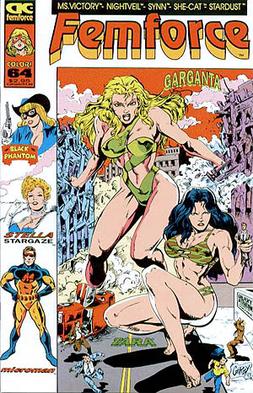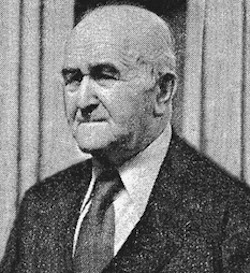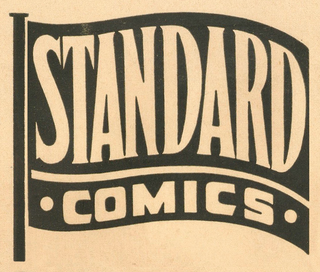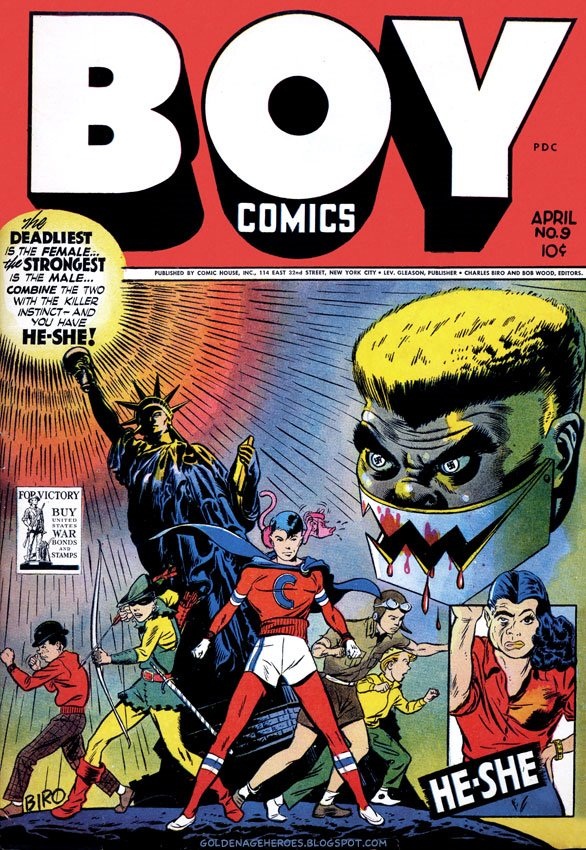
Femforce is a comic book published by AC Comics that began publication in 1985, detailing the adventures of the titular team: the "Federal Emergency Missions Force" or "Femforce", some of them original creations, while others originated in the 1940s and 1950s, lapsing into the public domain by the time Femforce was published. The team are, as their name implies, all superheroines, and are the first and the longest running all-women 'super-team'. The series has passed 200 issues, a significant milestone for an independent comic book company. Writers on the book have included Bill Black, Stephanie Sanderson, Mark Heike, Paul Monsky, Enrico Teodorani and Francesca Paolucci. Artists on the book have included Bill Black, Stephanie Sanderson, Mark Heike, Brad Gorby, Jeff Austin, Dave Roberts and Rik Levins.

Miss Victory is an American superheroine who first appeared in Captain Fearless #1, published by Frank Z. Temerson's Helnit Publishing Co. Ceasing to be published after 1946, she was revived and updated in 1984 as a central character in the Femforce comic-book series published by A.C. Comics.

Nightveil is a fictional character, a superheroine who appears in the Femforce comic book, published by AC Comics. An adaptation of the Golden Age superhero Phantom Lady, she has also been known as Blue Bulleteer and Nightfall. Her secret identity is Laura Wright, daughter of a member of the United States Senate.

Rad is a comic book supervillain in the Femforce comic published by AC Comics.

Miss America is a superhero appearing in American comic books published by Marvel Comics. Created by writer Otto Binder and artist Al Gabriele, the character first appeared in Marvel Mystery Comics #49 in the Golden Age of Comic Books. Madeline Joyce is the first incarnation of Miss America. The character has also been a member of the Invaders, Liberty Legion, and All-Winners Squad at various points in her history.

Phantom Lady is a fictional superheroine appearing in media published by Quality Comics and DC Comics. She was created by the Eisner & Iger studio, one of the first to produce comics on demand for publishers. The character's early adventures were drawn by Arthur Peddy.

Cat-Man and Kitten are a pair of fictional superhero characters created by artists Irwin Hasen (Cat-Man) and Charles M. Quinlan (Kitten) with unknown writers. Cat-Man was first published in 1940 by various Frank Z. Temerson companies. Due to circumstances during World War II, an altered version of Cat-Man was published in Australia and reprinted in the 1950s. AC Comics later revived the characters in the 1980s.

Harry Chesler, often credited as Harry "A" Chesler, with the "A" an affectation rather than a true initial, was the entrepreneur behind the first comic book packager of the late-1930s to 1940s Golden Age of comic books, supplying comics features and complete comic books to publishers testing the waters of the emerging medium.

Daredevil is a fictional superhero created by Jack Binder, who starred in comics from Lev Gleason Publications during the 1930s–1940s period historians and fans call the Golden Age of comic books before being retroactively established into the Image Universe by Image Comics in the 1990s as its first character. The character is unrelated to Marvel Comics' Daredevil, and recent renditions of the character have often renamed him Doubledare or The Death-Defying Devil to avoid confusion and potential lawsuits.

The Fighting Yank is the name of several superheroes, first appearing in Startling Comics #10.

The Blonde Phantom is a fictional masked crime fighter appearing in American comic books published by Marvel Comics. Created for Marvel predecessor Timely Comics by Stan Lee and Syd Shores, the character first appeared in All Select Comics #11, during the 1940s period fans and historians call the Golden Age of Comic Books. The heroine was so well received that the next issue was retitled The Blonde Phantom. The series continued to feature her until issue #22. She also appeared in backup stories in many other Timely comics; in Superhero Comics of the Golden Age, Mike Benton observes that "for a few months in 1948, readers could find her in seven titles on the newsstand." In The Supergirls, Mike Madrid asserted, "Once again, a capable woman hid behind a meek persona and only let her hair down, literally, to come to the aid of a man who completely ignored her unless she assumed a disguise. In a 1947 story entitled "I Hate Myself", Louise even dreams that Mark finally confesses his love for her, only to have the Blonde Phantom persona appear and steal him away."

Betsy Ross is a character appearing in American comic books published by Marvel Comics. Created by Joe Simon and Jack Kirby, the character first appeared in Captain America Comics #1. Betsy Ross is Captain America's early love interest and supporting character in American comic books published by Marvel Comics during the 1930-1940s period known to historians and collectors as the Golden Age of Comic Books. She then debuted as the superheroine Golden Girl in Captain America Comics #66.

Rulah, Jungle Goddess is a fictional character, a jungle girl, in comic books published by Fox Feature Syndicate. She first appeared in Zoot Comics #7. Matt Baker designed her, before Jack Kamen and Graham Ingels helped develop her image.

Standard Comics was a comic book imprint of American publisher Ned Pines, who also published pulp magazines and paperback books. Standard in turn was the parent company of two comic-book lines: Better Publications and Nedor Publishing. Collectors and historians sometimes refer to them collectively as "Standard/Better/Nedor".

Miss Masque is a fictional masked crime-fighter. She originally appeared in comic books published by Nedor Comics, and was later revived by AC Comics, America's Best Comics, and Dynamite Entertainment.

The Woman in Red is a fictional character that first appeared in the period known to comic book historians as the Golden Age of Comic Books. Created by writer Richard E. Hughes and artist George Mandel, she first appeared in Thrilling Comics #2, published by Nedor Comics. The character was later revived by writer Alan Moore for America's Best Comics. She would also be used by Dynamite Entertainment in Project Superpowers Chapter Two.

Captain Flight Comics is an American comic book series published by Four Star Publications during the period that is known by fans and historians as the Golden Age of Comic Books. A total of eleven issues were printed from March 1944 to February 1947. Noted artist L.B. Cole contributed his distinctive cover illustrations to many of the issues.

Fantomah is an American comics character, best known as one of the earliest comic-book superheroines. Created by Fletcher Hanks, the character first appeared in Jungle Comics #2, published by Fiction House. Hanks is also known for creating the equally strange Stardust the Super Wizard.

Crimebuster is a fictional boy hero, appearing as the lead feature in Boy Comics in the 1940s and 1950s. Dressed in a hockey uniform and cape, and accompanied by a performing monkey named Squeeks, he fights crime to avenge his parents' deaths. He is described by Joe Brancetelli in The World Encyclopedia of Comics as "a hero, yes, but first a boy... arguably the best-handled boy's adventure feature ever to appear in comics." Some sources credit the character solely to Charles Biro; others co-credit Bob Wood, co-credited on the first cover of the new Boy Comics title.

Shiera Sanders-Hall is a superheroine, the first Hawkgirl appearing in American comic books published by DC Comics. Shiera Sanders Hall was created by writer Gardner Fox and artist Dennis Neville, and first appeared in Flash Comics #1 as a romantic interest of Hawkman. Then later as one of DC's earliest super-heroines, she has appeared in many of the company's flagship team-up titles including the Justice Society of America.





















